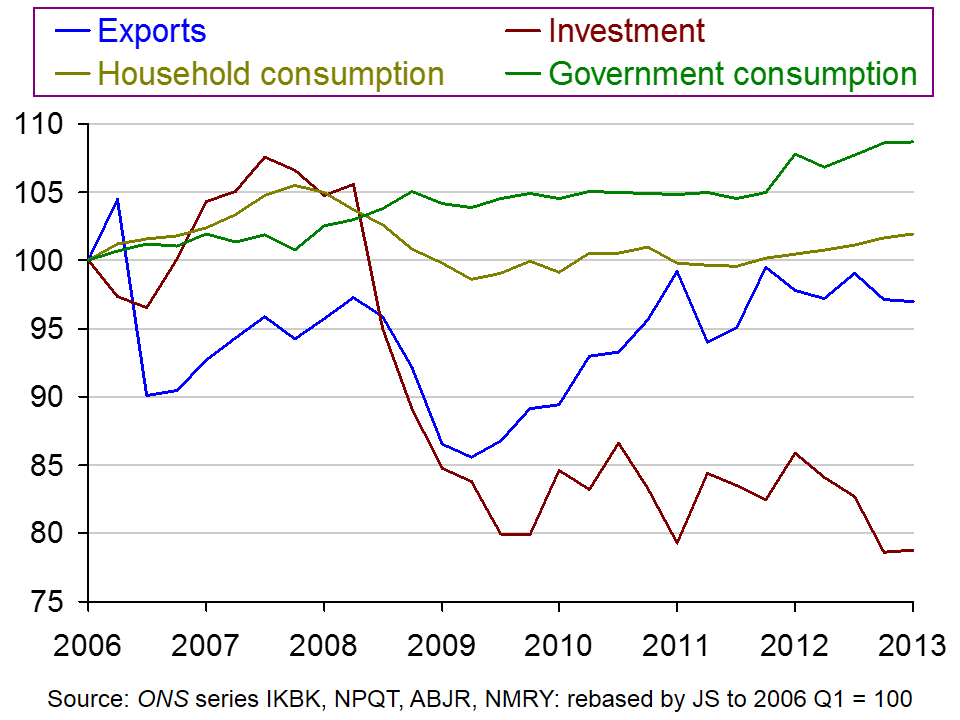 There’s some good news and some bad news about the UK economy. The good news is that there are signs that the recovery is gathering momentum; the ‘green shoots’ are growing bigger. The bad news is that it’s the ‘wrong type of growth’!
There’s some good news and some bad news about the UK economy. The good news is that there are signs that the recovery is gathering momentum; the ‘green shoots’ are growing bigger. The bad news is that it’s the ‘wrong type of growth’!
One of the main underlying problems of the 2008 financial crisis was that household debt had been increasing to unsustainable levels, egged on by banks only too willing to lend, whether as personal loans, on credit cards or through mortgages. When the recession hit, many people sought to reduce their debts by cutting back on spending. This further fuelled the recession.
What the government and most economists hoped was that there would be some rebalancing of the economy, with less reliance on consumer spending to drive economic growth. Instead it was hoped that growth would be driven by a rise in investment and exports. Indeed, the 25% depreciation of sterling exchange between 2007 and 2009 was seen as a major advantage as this would boost the demand for exports and encourage firms to invest in the export sector.
But things haven’t turned out the way people hoped. The recession (or lack of growth) has been much deeper and more prolonged than previous downturns in the economy. Today, real GDP per head is more than 7% below the level in 2007 and many people have seen much bigger declines in their living standards.
 But also, despite the austerity policies, the economy has not been ‘rebalanced’ towards exports and investment. Exports are 3% lower than in 2006 (although they did grow between 2009 Q2 and 2011 Q1, but have since stagnated). And investment is 27% lower than in 2006. Household consumption, however, has grown by about 2% and general government consumption by around 9% since 2006. The chart shows the figures, based on 2006 Q1 = 100.
But also, despite the austerity policies, the economy has not been ‘rebalanced’ towards exports and investment. Exports are 3% lower than in 2006 (although they did grow between 2009 Q2 and 2011 Q1, but have since stagnated). And investment is 27% lower than in 2006. Household consumption, however, has grown by about 2% and general government consumption by around 9% since 2006. The chart shows the figures, based on 2006 Q1 = 100.
(Click here for a PowerPoint of the chart.)
And recent evidence is that consumption is beginning to grow faster – not because of rising household incomes, but because of falling saving rates. In 2008, the household saving ratio had fallen to nearly 0% (i.e. households were on average saving about the same as they were borrowing). Then the saving ratio rose dramatically as people reined in their spending. Between 2009 and 2012, the ratio hovered around 7%. But in the first quarter of 2013, it had fallen to 4.2%
So the good news is that aggregate demand is rising, boosting economic growth. But the bad news is that, at least for the time being, this growth is being driven by a rise in household borrowing and a fall in household saving. The videos and articles consider whether this is, however, still good news on balance.
Webcasts
 Britain’s imbalanced economy The Economist, Zanny Minton Beddoes and Richard Davies (4/7/13)
Britain’s imbalanced economy The Economist, Zanny Minton Beddoes and Richard Davies (4/7/13)
 Britain’s Export Drought: an enduring disappointment The Economist, Andrew Palmer and Richard Davies (9/2/13)
Britain’s Export Drought: an enduring disappointment The Economist, Andrew Palmer and Richard Davies (9/2/13)
 ‘Green shoots’ of economic recovery in Rugby BBC News, Paul Mason (12/6/13)
‘Green shoots’ of economic recovery in Rugby BBC News, Paul Mason (12/6/13)
Articles
Is the UK economy seeing the ‘wrong kind’ of green shoots? BBC News, Stephanie Flanders (3/7/13)
The export drought: Better out than in The Economist (9/2/13)
Exports and the economy: Made in Britain The Economist (21/1/12)
The economy: On a wing and a credit card The Economist (6/7/13)
Unbalanced and unsustainable – this is the wrong kind of growth The Telegraph, Jeremy Warner (8/7/13)
The UK economy’s looking up – but no one’s told manufacturers The Guardian, Heather Stewart (10/7/13)
Data
Quarterly National Accounts, Q1 2013 (27/6/13)
Forecasts for the UK economy: a comparison of independent forecasts HM Treasury (June 2013)
ISM Manufacturing Report on Business® PMI History Institute for Supply Management
Questions
- What are forecasters expecting to happen to economic growth in the coming months? Why?
- What factors determine investment? Why has it fallen so substantially in the UK?
- Explain what is meant by the ‘accelerator’. Is the rise in consumption likely to lead to an accelerator effect and, if so, what will determine the size of this effect?
- Why have exports not grown more rapidly despite the depreciation of sterling after 2007?
- What will determine the rate of potential economic growth in the UK economy? How will a rise in real GDP driven by a rise in consumption impact on potential GDP and potential economic growth?
- What supply-side policies would you recommend, and why, in order to increase potential economic growth?
 The UK economy is suffering from a lack of aggregate demand. Low spending in real terms is preventing the economy from growing. A simple solution would seem to be to stimulate aggregate demand through fiscal policy, backed up by even looser monetary policy. But this is easier said than done and could result in undesirable consequences in the medium term.
The UK economy is suffering from a lack of aggregate demand. Low spending in real terms is preventing the economy from growing. A simple solution would seem to be to stimulate aggregate demand through fiscal policy, backed up by even looser monetary policy. But this is easier said than done and could result in undesirable consequences in the medium term.
If increased borrowing were to be used to fund increased government expenditure and/or cuts in taxes, would any resulting growth be sufficient in the medium term to reduce the public-sector deficit below the initial level through automatic fiscal stabilisers? And would the growth be sustainable? The answer to this second question depends on what happens to the supply side of the economy. Would there be an increase in aggregate supply to match the increase in aggregate demand?
 This second question has led many economists to argue that we need to see a rebalancing of the economy. What is needed is an increase in investment and exports, rather than an increase in just consumer expenditure funded by private borrowing and government current expenditure funded by public borrowing.
This second question has led many economists to argue that we need to see a rebalancing of the economy. What is needed is an increase in investment and exports, rather than an increase in just consumer expenditure funded by private borrowing and government current expenditure funded by public borrowing.
But how will exports and investment be stimulated? As far as exports are concerned, it was hoped that the depreciation of the pound since 2008 would give UK exporters a competitive advantage. Also domestic producers would gain a competitive advantage in the UK from imports becoming more expensive. But the current account deficit has actually deteriorated. According to the EU’s AMECO database, in 2008 the current account deficit was 1% of GDP; in 2012 it was 3.7%. It would seem that UK producers are not taking sufficient advantage of the pound’s depreciation, whether for exports or import substitutes.
 As far as investment is concerned, there are two major problems. The first is the ability to invest. This depends on financing and things such as available land and planning regulations. The second is the confidence to invest. With not little or no growth in consumer demand, there is little opportunity for the accelerator to work. And with forecasts of sluggish growth and austerity measures continuing for some years, there is little confidence in a resurgence in consumer demand in the future. (Click here for a PowerPoint of the above chart. Note that the 2013 plots are based on AMECO forecasts.)
As far as investment is concerned, there are two major problems. The first is the ability to invest. This depends on financing and things such as available land and planning regulations. The second is the confidence to invest. With not little or no growth in consumer demand, there is little opportunity for the accelerator to work. And with forecasts of sluggish growth and austerity measures continuing for some years, there is little confidence in a resurgence in consumer demand in the future. (Click here for a PowerPoint of the above chart. Note that the 2013 plots are based on AMECO forecasts.)
So hope of a rebalancing is faint at the current time. Hence the arguments for an increase in government capital expenditure that we looked at in the last blog post (The political dynamite of calm economic reflection). The problem and the options for government are considered in the following articles.
Articles
Budget 2013: Chancellor’s rebalancing act BBC News, Stephanie Flanders (11/3/13)
Why George Osborne is failing to rebalance the economy The Guardian, Larry Elliott (17/3/13)
Economy fails to ‘rebalance’ Financial Times, Sarah O’Connor (27/2/13)
Analysis – Long haul ahead for Britain’s struggling economy Reuters, William Schomberg (3/3/13)
Can banks be forced to lend more? BBC News, Robert Peston (12/3/13)
Budget 2013: What the commentators are saying BBC News (13/3/13)
Data
UK Trade, January 2013 (ONS) (12/3/13)
Business investment, Q4 2012 ONS (27/2/13)
Questions
- Draw a diagram to illustrate the effects of a successful policy to increase both aggregate demand and aggregate supply. What will determine the effect on the output gap?
- For what reasons has the UK’s current account deteriorated over the past few years while those of the USA and the eurozone have not?
- Using ONS data, find out what has happened to the UK’s balance of trade in (a) goods and (b) services over the past few years and explain your findings.
- Why are firms reluctant to invest at the moment? What policy measures could the government adopt to increase investment?
- With interest rates so low, why don’t consumers borrow and spend more, thereby aiding the recovery?
 Each month the accountancy firm BDO publishes its Business Trends Indices. These indices “are ‘polls of polls’ that pull together the results of all the main UK business surveys”. The latest report shows that the January 2013 Optimism Index was its lowest since the report began 21 years ago.
Each month the accountancy firm BDO publishes its Business Trends Indices. These indices “are ‘polls of polls’ that pull together the results of all the main UK business surveys”. The latest report shows that the January 2013 Optimism Index was its lowest since the report began 21 years ago.
The Optimism Index predicts business performance two quarters ahead. In January 2013 it was 88.9. The way the index is constructed, a reading of 95 or more suggests that firms are optimistic about business performance. Clearly, they were pessimistic.
 Although there was an increase in hiring intentions, firms were still predicting a fall in output. The indices for optimism, employment and output are shown in the chart. (Click here for a PowerPoint.)
Although there was an increase in hiring intentions, firms were still predicting a fall in output. The indices for optimism, employment and output are shown in the chart. (Click here for a PowerPoint.)
As Peter Hemington, Partner, BDO LLP, commented:
In spite of a strengthening Labour Market, business confidence continues to weaken, and improved hiring intentions are not translating into growth plans. It seems the damaging effects on businesses of five years’ zigzagging economic growth, has left them wary of making concrete plans for expansion and resigned to the ‘new normal’ of economic stagnation.
To end this cycle, it is imperative that the Government implements plans to expedite growth. Without growth incentives, we will continue to see UK businesses reluctant to invest and expand, which poses a grave threat to the UK’s economic recovery.
The following articles comment on the gloomy mood of business and on its implications for output and investment. They also look at the implications for government policy.
Articles
Confidence slumps despite optimism from manufacturers Insider News (11/2/13)
Fears of a triple-dip recession return as survey puts business confidence at a 21-year low This is Money (11/2/13)
Pressure grows on ministers for growth strategy Yorkshire Post (11/2/13)
Triple-dip jitters as business confidence hits 21-yr low Management Today, Michael Northcott (11/2/13)
Report and data
Business Trends: Business confidence hits 21-year low signalling economic contraction BDO Press Release (11/2/13)
BDO Monthly Business Trends Indices, February 2013 – Full Report BDO (11/2/13)
Business and Consumer Surveys European Commission: Economic and Financial Affairs
Questions
- What reasons are given by the report for a decline in business optimism?
- Explain how an accelerator/multiplier interaction could compound the recession or help to cause a bounce back from recession.
- How does business sentiment in one country affect business sentiment in others?
- In the absence of a change in its fiscal stance, what policies could the government adopt to increase business confidence?
- Why might firms’ hiring intentions increase even though they are predicting a fall in output?
Two reports on business confidence in the UK have just been published. The first, by Lloyds TSB Commercial, is its twice-yearly Business in Britain Report. The second is the Quarterly Economic Survey by the British Chambers of Commerce. Both reports paint a mixed picture about business confidence.
First the good news: the export sector is booming. Demand for exports is being boosted by (a) the depreciation of the pound, with the sterling exchange rate index some 20% lower now compared with the start of 2008 and (b) rapid economic growth in China, India and many other developing countries. Not surprisingly many exporting companies are looking to a bright future and are willing to invest.
Now the bad news. Domestic demand for many products is declining, especially services. This is not surprising given the rise in VAT, cuts in public spending and consumers cautious about their employment and income prospects in the coming year. With rapid cost-push inflation from higher oil and commodity prices, real incomes are set to fall and with it the level of real consumer demand (see Bosses gain – workers’ pain).
So where is the economy heading? The mixed picture painted by the two reports mean that the economy is likely to remain on the cusp. But with the export sector being much smaller than the domestic market, worries are likely to persist that economic growth may well slow significantly and the economy might return to recession. The main hope is that the restocking and replacement investment that follow a recession may be enough to provide just enough extra demand to avoid the ‘double dip’.
Articles
UK Business Confidence Hit By Domestic Demand Fears-Survey NASDAQ, Emma Haslett (4/1/11)
More doom and gloom as business confidence falls? Management Today, Nicholas Winning (5/1/11)
Smaller businesses do not share optimism Financial Times, Brian Groom (5/1/11)
New Year business confidence hit by domestic demand fears The Telegraph, James Hurley (5/1/11)
UK’s fragile services sector risks undermining recovery, BCC warns The Telegraph, Philip Aldrick (11/1/11)
Companies fear double-dip recession Oxford Mail, Andrew Smith (10/1/11)
Firms ‘planning investment freezes’ Press Association (4/1/11)
Surveys paint bleak picture for British economy Reuters, David Milliken (11/1/11)
 Kern Says U.K. Services Industry Growth Is `Mediocre’ Bloomberg, Watch Video, David Kern (11/1/11)
Kern Says U.K. Services Industry Growth Is `Mediocre’ Bloomberg, Watch Video, David Kern (11/1/11)
UK economic growth rate slowing, BCC says BBC News (11/1/11)
Reports
Business in Britain, December 2010 Lloyds TSB Commercial (January 2011)
Quarterly Economic Survey, Q4 2010: Summary British Chambers of Commerce (January 2011)
Quarterly Economic Survey, Q4 2010: Tables British Chambers of Commerce (January 2011)
Data
Interest Rates and Exchange Rates Bank of England (for sterling effective exchange rates)
Economic and Labour Market Review Office for National Statistics (see Tables Chapter 1, worksheets in Table 1.03 for components of aggregate demand)
Business and Consumer Surveys European Commission, Economic and Financial Affairs (see latest ESI – Economic Sentiment Indicator, Table 1)
Questions
- Summarise the findings of the two reports.
- Using the data in Table 1.03 of the Economic and Labour Market Review, calculate the percentage of UK GDP accounted for by each of the main elements of aggregate expenditure.
- Why is the manufacturing sector as a whole experiencing relatively strong economic growth?
- If the service sector shrank by x% and the manufacturing sector grew by x%, what would be likely to happen to the rate of economic growth in the economy? What else would you need to know to establish the precise rate of economic growth?
- The BCC said both the government and the Bank of England must “act forcefully to support growth”. What measures would this include?
- If real wages fall, what could cause real aggregate demand to rise in these circumstances?
- What is likely to drive the level of investment in the coming months?
Keynes referred to the ‘paradox of thrift’ (see, for example, Box 17.5 on page 492 of Sloman and Wride, Economics, 7th edition). The paradox goes something like this: if individuals save more, they will increase their consumption possibilities in the future. If society saves more, however, this may reduce its future income and consumption. Why should this be so? Well, as people in general save more, they will spend less. Firms will thus produce less. What is more, the lower consumption will discourage firms from investing. Thus, through both the multiplier and the accelerator, GDP will fall.
What we have in the paradox of thrift is an example of the ‘fallacy of composition’ (see Sloman and Wride, Box 3.7 on page 84). What applies at the individual level will not necessarily apply at the aggregate level. The paradox of thrift applied in the Great Depression of the 1930s. People cutting back on consumption drove the world economy further into depression.
Turn the clock forward some 80 years. On 26/27 June 2010, leaders of the G20 countries met in Canada to consider, amongst other things, how to protect the global economic recovery while tackling the large public-sector deficits. These deficits have soared as a result of two things: (a) the recession of 2008/9, which reduced tax revenues and resulted in more people claiming benefits, (b) the expansionary fiscal policies adopted to bring countries out of recession.
But the leaders were divided on how much to cut now. Some, such as the new Coalition government in the UK, want to cut the deficit quickly in order to appease markets and avert a Greek-style crisis and a lack of confidence in the government’s ability to service the debt. Others, such as the Obama Administration in the USA, want to cut more slowly so as not to put the recovery in jeopardy. Nevertheless, cuts were generally agreed, although agreement about the timing was more vague.
So where is the fallacy of composition? If one country cuts, then it is possible that increased demand from other countries could drive recovery. If all countries cut, however, the world may go back into recession. What applies to one country, therefore, may not apply to the world as a whole.
Let’s look at this in a bit more detail and consider the individual elements of aggregate demand. If there are to be cuts in government expenditure, then there has to be a corresponding increase in aggregate demand elsewhere, if growth is to be maintained. This could come from increased consumption. But, with higher taxes and many people saving more (or reducing their borrowing) for fear of being made redundant or, at least, of having a cut in their incomes, there seems to be little sign that consumption will be the driver of growth.
Then there is investment. But, fearing a ‘double-dip recession’, business confidence is plummeting (see) and firms are likely to be increasingly reluctant to invest. Indeed, after the G20 summit, stock markets around the world fell. On 29 June, the FTSE 100 fell by 3.10% and the main German and French stock market indices, the Dax and the Cac 40, fell by 3.33% and 4.01% respectively. This was partly because of worries about re-financing the debts of various European countries, but it was partly because of fears about recovery stalling.
The problem is that cuts in government expenditure and rises in taxes directly affect the private sector. If government capital expenditure is cut, this will directly affect the construction industry. Even if the government makes simple efficiency savings, such as reducing the consumption of paper clips or paper, this will directly affect the private stationery industry. If taxes are raised, consumers are likely to buy less. Under these circumstances, no wonder many industries are reluctant to invest.
This leaves net exports (exports minus imports). Countries generally are hoping for a rise in exports as a way of maintaining aggregate demand. But here we have the fallacy of composition in its starkest form. If one country exports more, then this can boost its aggregate demand. But if all countries in total are to export more, this can only be achieved if there is an equivalent increase in global imports: after all, someone has to buy the exports! And again, with growth faltering, the global demand for imports is likely to fall, or at best slow down.
The following articles consider the compatibility of cuts and growth. Is there a ‘paradox of cuts’ equivalent to the paradox of thrift?
Articles
Osborne’s first Budget? It’s wrong, wrong, wrong! Independent on Sunday, Joseph Stiglitz (27/6/10)
Strategy: Focus switches from exit to growth Financial Times, Chris Giles (25/6/10)
Once again we must ask: ‘Who governs?’ Financial Times, Robert Skidelsky (16/6/10)
Europe’s next top bailout… MoneyWeb, Guy Monson and Subitha Subramaniam (9/6/10)
Hawks hovering over G20 summit Financial Times (25/6/10)
G20 applauds fiscal austerity but allows for national discretion Independent, Andrew Grice and David Usborne (28/6/10)
To stimulate or not to stimulate? That is the question Independent, Stephen King (28/6/10)
Now even the US catches the deficit reduction habit Telegraph, Jeremy Warner (28/6/10)
George Osborne claims G20 success Guardian, Larry Elliott and Patrick Wintour (28/6/10)
G20 accord: you go your way, I’ll go mine Guardian, Larry Elliott (28/6/10)
G20 summit agrees on deficit cuts by 2013 BBC News (28/6/10)
IMF says G20 could do better BBC News blogs: Stephanomics, Stephanie Flanders (27/6/10)
Are G20 summits worth having? What should the G20’s top priority be? (Economics by invitation): see in particular The G20 is heading for a “public sector paradox of thrift”, John Makin The Economist (25/6/10)
 Why it is right for central banks to keep printing Financial Times, Martin Wolf (22/6/10)
Why it is right for central banks to keep printing Financial Times, Martin Wolf (22/6/10)
In graphics: Eurozone in crisis: Recovery Measures BBC News (24/6/10)
A prophet in his own house The Economist (1/7/10)
The long and the short of fiscal policy Financial Times, Clive Crook (4/7/10)
G20 Communiqué
The G20 Toronto Summit Declaration (27/6/10) (see particularly paragraph 10)
Questions
- Consider the arguments that economic growth and cutting deficits are (a) complementary aims (b) contradictory aims.
- Is there necessarily a ‘paradox of cuts’? Explain.
- How is game theory relevant in explaining the outcome of international negotiations, such as those at the G20 summit?
- Would it be wise for further quantitative easing to accompany fiscal tightening?
- What is the best way for governments to avoid a ‘double-dip recession’?
 There’s some good news and some bad news about the UK economy. The good news is that there are signs that the recovery is gathering momentum; the ‘green shoots’ are growing bigger. The bad news is that it’s the ‘wrong type of growth’!
There’s some good news and some bad news about the UK economy. The good news is that there are signs that the recovery is gathering momentum; the ‘green shoots’ are growing bigger. The bad news is that it’s the ‘wrong type of growth’!  But also, despite the austerity policies, the economy has not been ‘rebalanced’ towards exports and investment. Exports are 3% lower than in 2006 (although they did grow between 2009 Q2 and 2011 Q1, but have since stagnated). And investment is 27% lower than in 2006. Household consumption, however, has grown by about 2% and general government consumption by around 9% since 2006. The chart shows the figures, based on 2006 Q1 = 100.
But also, despite the austerity policies, the economy has not been ‘rebalanced’ towards exports and investment. Exports are 3% lower than in 2006 (although they did grow between 2009 Q2 and 2011 Q1, but have since stagnated). And investment is 27% lower than in 2006. Household consumption, however, has grown by about 2% and general government consumption by around 9% since 2006. The chart shows the figures, based on 2006 Q1 = 100. Britain’s imbalanced economy The Economist, Zanny Minton Beddoes and Richard Davies (4/7/13)
Britain’s imbalanced economy The Economist, Zanny Minton Beddoes and Richard Davies (4/7/13) Britain’s Export Drought: an enduring disappointment The Economist, Andrew Palmer and Richard Davies (9/2/13)
Britain’s Export Drought: an enduring disappointment The Economist, Andrew Palmer and Richard Davies (9/2/13) ‘Green shoots’ of economic recovery in Rugby BBC News, Paul Mason (12/6/13)
‘Green shoots’ of economic recovery in Rugby BBC News, Paul Mason (12/6/13)



